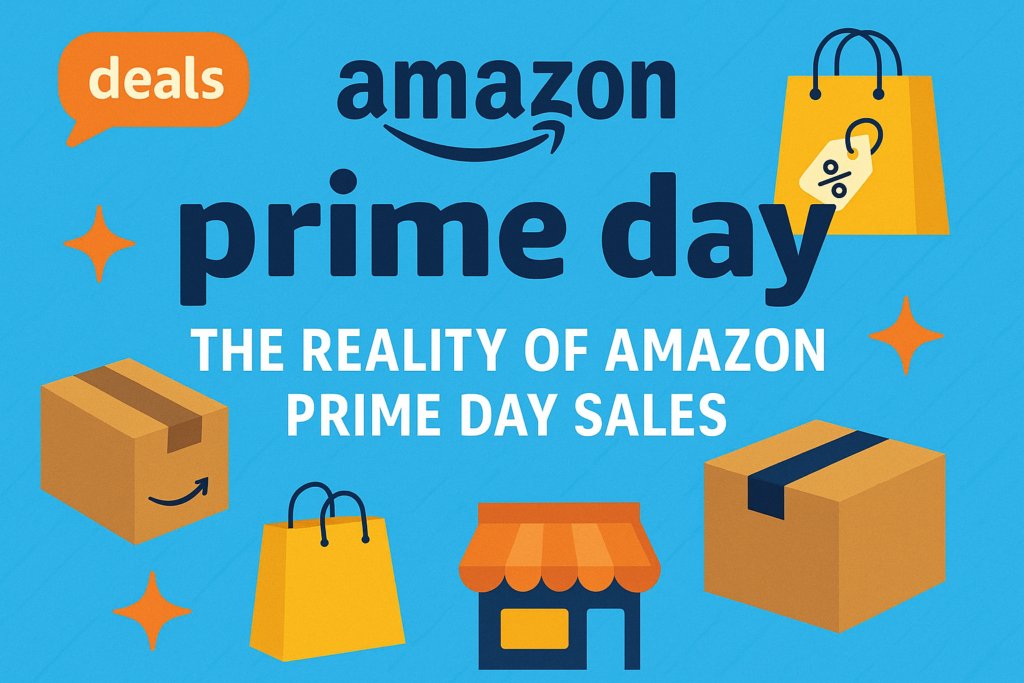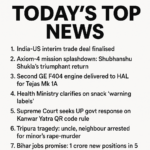By Aman
Every July, millions of Indians eagerly await Amazon Prime Day—the online retail extravaganza promising blockbuster discounts, jaw-dropping deals, and a chance to nab that coveted gadget, appliance or kitchenware at an unbeatable price.
This year’s edition — stretched across July 12 to 14, 2025, for the first time in India — was Amazon’s boldest yet. But as the dust settles, what does the reality behind the hype reveal? Did Prime Day truly live up to expectations, or are the headlines a little… inflated?
1. The Extended Format: More Days, Less Frenzy?
In the US earlier this July, Amazon stretched Prime Day to four days (July 8–11), a sweeping move aimed at reducing shopping urgency and spreading the bang over a longer period The Economic Times+2The Financial Express+2Carbon6+2. Now in India, they’ve mirrored that by expanding the event from the traditional two days to a full three days (July 12–14) Carbon6+1The Financial Express+1.
At first glance, it seems logical: more days means more chances for shoppers to grab deals—no more midnight checkout marathons or frantic FOMO. Amazon’s pitch? Prime members now enjoy an extra 24 hours to explore 1,600+ new products across 400+ brands IN About Amazon+1The Financial Express+1.
But here’s the catch: reports from the US suggest that the first few hours of the expanded Prime Day saw a 41% drop in sales, compared to the traditional launch-day frenzy The Economic Times+2The Financial Express+2Forbes+2. Clearly, the urgency that fueled past events is being diluted.
In India, anecdotal insights and emerging sales data hint at a similar trend. While electronics, home décor, and wellness witnessed impressive uptake, the smartphone segment lagged, even when offering heavy discounts The Economic Times+1Indiatimes+1.
2. Category Winners and Laggards
🏆 Electronics, Home & Fitness Soar
The Economic Times reports 3–4× growth in brand sales across electronics, home, beauty, and fitness compared to regular days The Economic Times+1Carbon6+1. For established names like Solara (home & kitchen), initial days delivered a 5–6× spike in orders, outperforming last year . Fitness and personal care brands are also calling it their best Prime Day, with multi-fold growth .
📱 Smartphones Trail Behind
Despite banner offers on devices like iPhone 15, Galaxy S24 Ultra and OnePlus 13R, growth in the smartphone category was “not as significant.” Datum Intelligence’s Satish Meena notes that smartphone sales “reflected the market itself, which is also down” Indiatimes+2The Economic Times+2The Financial Express+2.
That mirrors global tech trends—with Counterpoint trimming 2025’s global smartphone growth forecast to 1.9% due to sluggish demand The Economic Times.
🛒 Value Buying on Essentials
In the US, Adobe Digital Insights notes shoppers gravitated toward everyday items: dish soap, protein shakes, cleaning supplies—two-thirds of transactions were for items under $20; only 3% of items sold cost over $100 The Financial Express.
While India doesn’t have direct figures, testimonials from FMCG and grocery sellers suggest a surge in practical, daily-use purchases—consistent with the trend of value-focused consumer behaviour.
3. Double-Edged Sword: Discounts Versus Demand
Amazon promises “double the number of deals with 50% or more off” The Financial Express. In India, offers include up to ₹6,250 extra savings for ICICI/SBI cardholders, bank offers across categories, and enticing exchange bonuses Indiatimes.
But a “discount carnival” isn’t always a sales jackpot:
- US Momentum Commerce flagged a 41% plunge in early sales, attributing it partly to consumers pacing their purchases over the extended window The Financial Express+1Forbes+1.
- Globally, Amazon counters by saying delayed buying is the real reason—not a falloff in interest .
In India, there’s an undercurrent that certain brands are leveraging Prime Day to offload inventory ahead of the festive season—discounts are strong, but not necessarily indicative of spike in new demand The Economic Times.
4. Amazon’s Position: “Biggest Ever” but Buyer Behaviour is Changing
The global narrative is a mixed bag:
- Amazon calls it the “biggest ever” Prime Day, pointing to strength in categories like appliances (+36%), sporting goods (+30%) and electronics (+57%) coresight.com+8seekingalpha.com+8youtube.com+8.
- Meanwhile, Bloomberg and Momentum note that a 9.9% rise in Day 1 sales to $7.9 billion may signal a slowdown in growth pace Forbes+1The Financial Express+1.
In India, Amazon reports earlier days are encouraging, with expanding categories and banking offers driving engagement . But they remain tactically tight-lipped on comparing 2025 against 2024 in concrete terms.
5. The Seller/Brand Angle: A Shifting Landscape
Brands and sellers have mixed reviews:
- Some credit phenomenal spikes: Solara’s 5–6×, personal care companies 2× growth, and strong performance in tier II/III accounts (~50–55% orders) The Economic Times.
- But others caution: steep tariffs (145%) on Chinese imports, mounting ad costs, and inflated logistics are pushing firms to rethink their Prime Day strategy youtube.com+1Carbon6+1.
One ecommerce analyst noted brands are pulling back ad spending and trimming discounts or choosing alternative platforms like Walmart and TikTok Shop, to avoid high tariffs and Amazon fees Carbon6.
6. The Competitive Landscape: A Retail Sales Storm
Prime Day no longer stands alone. It’s become the fulcrum of a July retail war:
- Walmart, Target, Best Buy and TikTok Shop are all running overlapping “Summer Sale Weeks” featuring special pricing, membership perks, and influencer collaborations Carbon6.
- Amazon itself is doubling ad commissions for influencers (from 3→6% in beauty, 4→8% in jewellery), while pushing brands to hike daily ad budgets by 100% during the event—mirroring global supply chain stresses from tariffs and inflation Carbon6.
The effect? Consumers are spoiled for choice. With multiple platforms offering windfalls, loyalty is less important than who publishes the best markdown.
7. Final Take: The Reality Check
✔ Growth, But Not Universal
Prime Day unquestionably works — electronics, home, beauty, wellness, and basics have seen strong uptake. But premium segments like smartphones face headwinds, echoing broader cooling in demand.
✔ Strategy Over Hype
Brands that entered with smart inventory planning, flexible logistics, and sensible ad spend — those are the winners. Industry insiders report Amazon steers brands aggressively toward bigger ad budgets and higher commissions, but ROI must justify the cost Carbon6.
✔ Consumer Shift
Buyers are reallocating budgets. Lower ticket items—groceries, cleaning products, kitchen staples—are topping shopping lists. Even higher-ticket devices often are meant as gifts or upgraded essentials—rarely impulse splurges.
✔ Calendar of Deals
Mid-July is now the unofficial global summer sale season. Amazon may still lead, but rivals and emerging platforms are grabbing big chunks of the action by running concurrent events. Consumers are hunting deals across several carts, not just one.
8. What’s Next?
Festive season preview: Prime Day is now a springboard into September–November shopping festivals. Strong Q3 numbers here set the tone for earnings and strategy.
Tariff rethink: Chinese-made electronics and accessories are facing punitive import taxes. Brands may pivot toward local manufacturing or domestic sourcing for future Prime events.
Consumer experience: Amazon’s new AI assistant “Rufus” is being rolled out to improve product discovery. It’ll be interesting to see how live chat support and AI curation impact conversion rates Carbon6.
Ad fatigue: With sellers doubling their spending and influencers flocking to the event, audiences may begin tuning out. The mid-year retail battlefield is crowded and attention spans are limited.
9. Four Key Takeaways for Stakeholders
- For Amazon:
- The extended format dilutes rush but broadens momentum.
- Expanding tiers and categories propels volume.
- Global narrative is mixed—it’s big, but growth is moderating.
- For Brands:
- Short-term spikes can obscure long-term brand health.
- Tariffs and the marketing arms race demand discipline.
- Multi-platform strategy is essential—don’t depend on Amazon alone.
- For Consumers:
- Prices are attractive, especially in mid‑price brackets.
- Smartphones and luxury gadgets may still be better priced during later festive events.
- Compare deals—Amazon’s exclusivity is less stark when rivals follow suit.
- For Investors & Analysts:
- Prime Day is a health barometer, but not the whole market.
- Stock volatility may rise post-event as Q2 reports and tariffs play out.
- Extension of the event suggests Amazon is doubling down on engagement.
Final Word
Prime Day is still Amazon’s pièce de résistance in mid-year ecommerce — a festive mashup of flash sales, loyalty perks, AI-driven experiences and marketing blitzes. But the reality check is clear:
- When deals are stretched over three days, armchair shoppers wait.
- When tariffs squeeze margins, brands trim campaigns.
- When competitors pounce, shoppers explore.
Yet, despite these evolving dynamics, Prime Day remains a watershed moment — priming the market, setting discount expectations, and shaping supply chain strategy for the rest of the year.
As we edge toward the festive peak in autumn, one truth endures: deals may blur, but demand endures—a season of stories, sales, and scoreboard-watching has only just begun.
This post was written by Aman for cnbindia.com.


